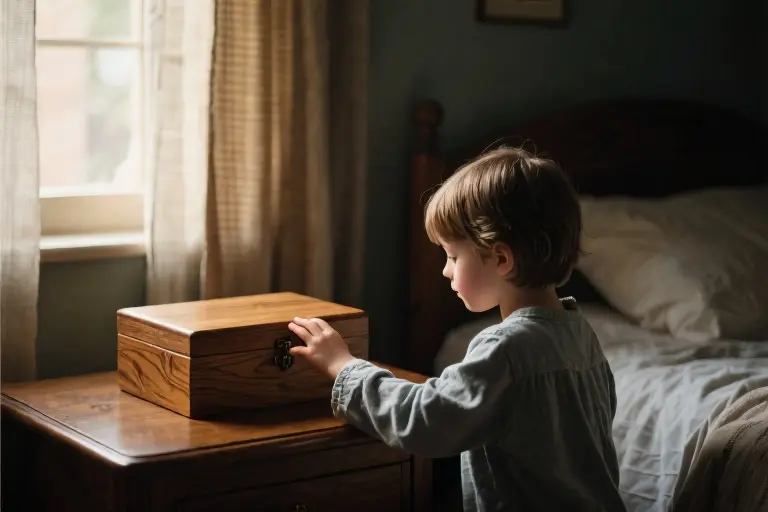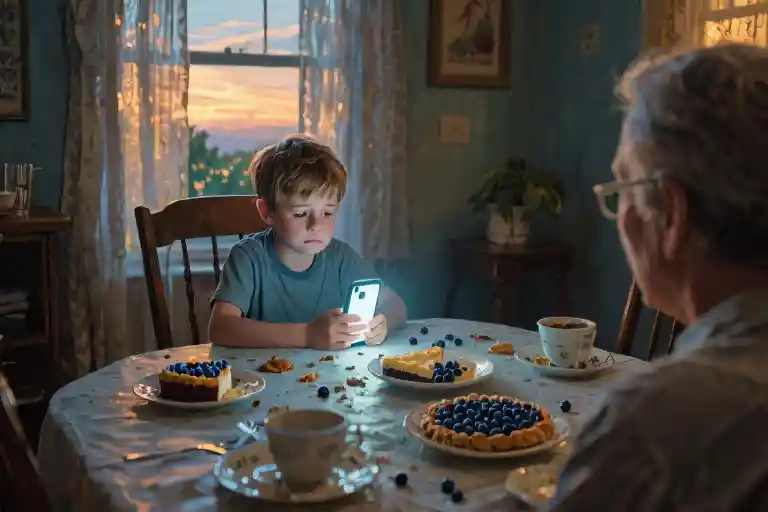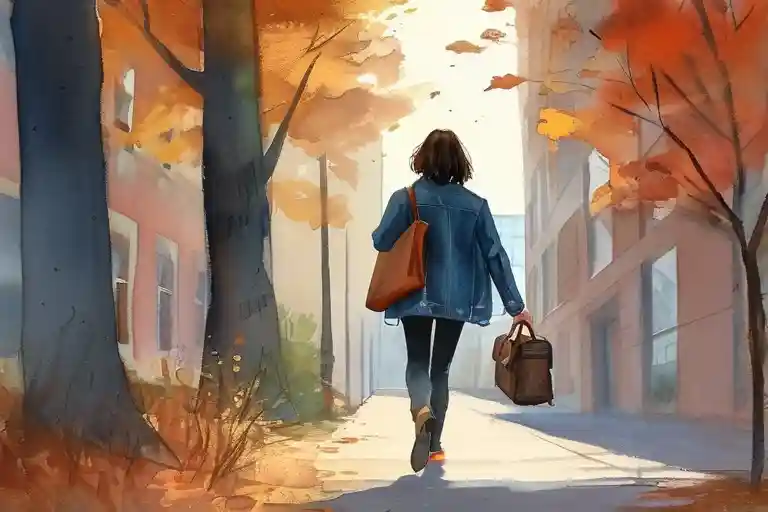The teaspoon clinked against the porcelain cup with a sound that still echoes in my memory—a tiny, trembling bell announcing the beginning of an ordinary morning that would hold extraordinary meaning. My father’s hand hovered over his tea, the silver spoon catching early light as it stirred clockwise, dissolving sugar crystals that swirled like miniature galaxies. His knuckles were pale with pressure, though his face showed nothing. That was the first time I noticed how fear could wear the mask of routine.
‘You’ll be late,’ he said without looking up, but his fingers betrayed him. A single drop of tea escaped the cup’s rim, tracing a slow path down his wrist like the first crack in a dam. It was years before I understood that some dreams don’t end when we wake up—they seep into our waking hours, coloring the mundane with their lingering shadows.
That morning marked the only time my father ever showed me his fear raw and unfiltered. Between the steam rising from our breakfast congee and the distant honking of school-bound traffic, he shared the dream that would become our family’s silent touchstone. Not with dramatic confession, but in the way his thumb kept rubbing the spoon’s handle long after the sugar had disappeared, as if trying to erase some invisible stain.
The kitchen smelled of jasmine tea and toasted sesame oil, ordinary scents that somehow made the moment more sacred. I can still see the sunlight cutting through our lace curtains, casting web-like shadows across his work shirt where he’d missed a button. These details matter because they were the anchors holding him to reality while describing something far beyond it—a golden afternoon, a crumbling temple, and the approach of something primal even a child could recognize as danger.
He spoke in the flat tone reserved for discussing weather or train schedules, yet his left knee bounced under the table like a trapped bird. I didn’t recognize the significance then, how rare it was for this man who rebuilt engines and lifted sacks of rice without strain to admit helplessness, even symbolically. The dream’s terror wasn’t in the lion’s appearance, but in his paralysis—the father who could fix anything suddenly rendered powerless.
When the school bell rang that day, I carried the story lightly, a curious trinket to examine during boring lessons. Only much later would I appreciate the weight of what he’d handed me—not just a strange nighttime narrative, but the key to decoding all the unspoken anxieties that shaped our family’s particular language of love. That teaspoon’s rhythmic circling became the first turn in a labyrinth I’m still navigating, each subsequent year revealing new corners of its design.
Every family has these inherited dreams, I’ve come to realize—not the sleeping kind, but the waking visions that pass between generations like fragile heirlooms. Their power lies not in resolution, but in their persistence, the way they resurface when we least expect them. My father’s lion still paces the edges of my consciousness, especially now when I watch my own children play in gilded sunlight, their laughter rising like bubbles no parent can truly catch.
The Gilded Dusk
The memory comes back to me in fragments, like sunlight breaking through old temple walls. I was nine years old when my father first described his dream – that strange twilight vision that would haunt both our lives in different ways.
In his telling, the golden hour stretched impossibly long. I saw myself through his sleeping eyes: a small figure crouched by the riverbank near the abandoned temple, fingers tracing smooth pebbles worn by generations of water. The setting sun turned everything luminous – my cotton shirt, the dusty path, even the crumbling red bricks of the ancient shrine. Laughter bubbled up as children’s laughter does, effortless and bright against the quiet hum of cicadas.
Then the shadows shifted.
From behind the fractured temple wall emerged something that didn’t belong in our sleepy provincial town – a lion, its massive shoulders dusted with the same gold light that gilded my childish treasures. In dreams, terror often arrives beautifully. The beast moved with deliberate grace, each paw pressing indents into sun-warmed earth where I’d just skipped barefoot. Its mane caught fragments of dying light like a crown of embers.
What stays with me most isn’t the lion’s approach, but the surreal stillness of that moment. No birds took flight. No wind stirred the tall grass. Just the hypnotic clink of pebbles dropping from my hands as I turned, finally sensing the presence that had already pinned me in its gaze.
Years later, studying psychology in college, I’d learn about the ‘sunset effect’ in traumatic memories – how our minds often frame crises in dramatic lighting. But back then, all I understood was the strange weight in my father’s voice when he described watching helplessly from some invisible vantage point, his dream-self paralyzed as the distance between predator and child dissolved.
That golden hour became our private mythology. The pebbles I’d collected transformed in my memory – were they playthings or primitive weapons? The temple walls, once just part of the neighborhood’s worn landscape, took on new significance. Their cracks now seemed to map the fault lines in my father’s protective instincts.
Sometimes at bedtime, my own daughter asks me to describe the lion. ‘Did it have a big fluffy mane like Simba?’ she’ll ask, and I’ll smile at how innocence recasts nightmares. But when I close my eyes, I still see it exactly as my father did – not as a cartoon villain, but as something ancient and inevitable, moving through gilded light toward all the vulnerable things we love.
The Ritual of Silence
The kitchen smelled of burnt toast and bergamot that morning, the steam from my father’s tea curling around his face like a veil. He always made Earl Grey at 6:45 AM, stirring in precisely two sugar cubes until they dissolved completely—a ritual so practiced his hand could perform it while his mind wandered elsewhere. That day, his fingers trembled slightly when passing me the chipped blue plate with its single slice of overcooked bread.
Between us, the radio murmured a weather report. Scattered showers moving eastward. Static crackled through the forecast like distant thunder. I remember counting the seconds of silence after his dream confession: seventeen heartbeats where neither of us acknowledged the lion still prowling through our breakfast table.
The mechanics of avoidance revealed themselves in microscopic details:
- The way his knuckles whitened around the teaspoon
- The deliberate chew-swallow rhythm he adopted
- His gaze fixed somewhere beyond the window where the real temple stood
Three times I opened my mouth to ask about the dream’s ending. Three times I closed it, watching sugar crystals sink to the bottom of my own untouched tea. The radio filled our conversational voids with trivialities—humidity percentages, pollen counts—until the mundane crowded out the monstrous.
Later, I’d recognize this as our family’s survival mechanism. When words failed, we perfected the art of meaningful mundanity:
- The Bread Offering – His way of saying I’m still here
- The Weather Barrier – Using forecasts as emotional insulation
- The Unfinished Confession – Leaving space for my own interpretations
That morning’s peculiar alchemy transformed ordinary objects into emotional artifacts. The toaster’s ping became a punctuation mark. The dripping faucet kept time like a metronome for our unsaid thoughts. Even now, the scent of oversteeped Earl Grey carries the metallic tang of restrained fear.
What fascinates me most in retrospect isn’t the terrifying dream, but the daylight aftermath. How my father rebuilt normalcy brick by brick—butter knife scraping across toast, schoolbag zipper’s decisive shhhk, the front door’s familiar groan—as if domestic routine could cage whatever haunted his sleep. The true revelation wasn’t his nighttime vulnerability, but his daylight determination to protect me from it.
We inherit more than genes—we inherit coping mechanisms. That morning taught me silence can be its own language, that love sometimes wears the disguise of routine, and that the strongest walls are often built with unspoken bricks.
The Archaeology of Adulthood
Two decades after that breakfast conversation, I found myself standing in my childhood home’s attic, dust motes dancing in the slanted afternoon light. I was there to clear out old boxes after my father’s passing, a task that felt equal parts sacred and invasive. Between stacks of yellowed newspapers and outdated electronics, my fingers brushed against a small leather-bound notebook – the kind bank tellers used in old movies.
Opening it revealed my father’s cramped handwriting, the ink faded but still legible. The pages contained not personal reflections as I’d hoped, but meticulous records: daily expenses, weather observations, and most strikingly, a dated entry from the week before his lion dream. In stark capital letters it read: ‘PLANT CLOSING NOTICE – 90 DAYS.’ Beneath it, calculations of our mortgage payments with increasingly frantic question marks.
That’s when the pieces began shifting. The temple in his dream wasn’t just any ruin – it was the abandoned textile mill where he’d worked for fifteen years, its collapsed walls mirroring the factory’s broken windows. The golden sunset? His severance package would last until autumn. And the lion… I traced my thumb over a coffee-stained corner where he’d doodled a crude lion’s head beside the words ‘union rep.’
In the bottom drawer of his desk, I discovered an envelope marked ‘Temple Photos.’ Inside, faded Kodak prints showed our family picnicking near the mill in better days. One photo caught my breath – my nine-year-old self squatting near the foundation, pebbles in both hands. And there, just visible on the weathered brick behind me… three parallel marks that could’ve been erosion patterns. Or claw marks.
That night, I dreamt of my father standing in our old kitchen, stirring endless cups of tea. When he turned to me, his face kept shifting between his 35-year-old self and how he looked in hospice. ‘Some walls,’ he said without moving his lips, ‘aren’t meant to keep things out. They show us where we’ve been contained.’
I woke with my own child’s cry monitor crackling to life down the hall. As I walked to her room, it occurred to me that we spend our lives translating our parents’ dreams, only to realize we’re deciphering our own futures. The lion never changes. Only our understanding of what it guards – or what it’s waiting to protect us from.
Boxes waiting in my garage:
- Mill worker pay stubs (1978-1992)
- Newspaper clipping: ‘Local Plant Closes’
- 1 envelope labeled ‘Do Not Open Until You Dream of Water’ (unopened)
- 37 smooth pebbles in a mason jar
The Flow of Symbols
The lion in my father’s dream never left me. It prowled through my subconscious for decades, its golden mane flickering at the edges of memory whenever I encountered the creature in storybooks, zodiac charts, or nature documentaries. What startled me most wasn’t its universal symbolism as the ‘king of beasts,’ but how differently cultures clothed this predator in meaning.
In our family album, pressed between onion-skin pages, I found photographs of my great-grandfather posing beside a lion carcass during his colonial service in Africa. The sepia-toned hunter wore the same tight smile my father reserved for uncomfortable social functions. Later, I’d discover Celtic legends where lions represented solar energy, Buddhist tales where they symbolized enlightened courage, and Mesopotamian carvings where they guarded sacred spaces. Each interpretation refracted light on that childhood dream – was the lion an ancestral warning? A test of spiritual strength? Or simply my father’s subconscious dressing his fears in the most formidable pelt available?
Then there were the pebbles. Those ordinary stones I’d been gathering when the lion appeared became my personal Rosetta Stone for decoding memory. Smooth from years of handling, they now live in my writing desk drawer – not as talismans or paperweights, but as tactile reminders of how childhood distills complex emotions into simple objects. Psychologists call this ‘symbolic encoding,’ where the mind packages overwhelming experiences into manageable metaphors. My nine-year-old self understood playing with stones; the approaching lion required translation.
Modern dream analysis suggests we don’t remember random nighttime stories, but rather the ones our psyche tags as important. The pebbles became my father’s unspoken message in bottle form – perhaps representing the small, hard truths he couldn’t articulate over breakfast. When my own child now asks why I keep ‘boring old rocks,’ I simply let her arrange them into patterns on my desk. Some symbols resist explanation; their power lives in the spaces between what’s said and what’s felt.
This fluidity of meaning fascinates me most. The same lion that represented mortal danger in my father’s dream appears on the crest of our local library, symbolizing guardianship of knowledge. The temple walls that crumbled in his subconscious still stand physically in our neighborhood, though their original protective purpose has faded with time. Symbols breathe – they expand and contract with our lived experience, yet retain some essential shape that makes them recognizable across generations.
Perhaps this explains why certain dreams haunt families like heirlooms. They’re not static paintings, but living sculptures we collaboratively shape through retelling and remembering. My father saw a threat; I inherited a puzzle; my daughter will likely fashion something entirely new from these same elemental pieces. The symbols persist, but their significance flows around our needs like water finding its level.
What family symbols have evolved in your understanding over time? The childhood monster under your bed that later revealed itself as financial instability? The ‘friendly ghost’ stories that masked a relative’s depression? We carry these coded messages until life gives us the key – or until we realize the code itself was never the point, but rather the connection forged in the deciphering.
The Pebbles in My Drawer
My daughter found them yesterday, those smooth river stones tucked behind my socks. Her small fingers closed around one, holding it up to the light like a newfound treasure. “Daddy, why do you keep these?” she asked, and my hand froze mid-air—just as my father’s had decades ago when I’d asked about his dream.
They aren’t keepsakes, these pebbles. Not exactly. Nor are they warnings, though they once might have been. Over the years, they’ve become something else entirely—silent witnesses to the generational echoes of protection and fear.
When I became a father myself, I finally understood the weight of that unanswered dream. The lion wasn’t just a predator; it was every unspoken threat lurking beyond a parent’s control. The crumbling temple walls mirrored the fragile barriers we build between our children and the world’s sharp edges. And those golden pebbles? They were the moments of childhood innocence we desperately try to preserve, even as they slip through our fingers like sand.
My daughter waits for an answer, turning the stone over in her palm. I see my father’s dream reflected in her expectant eyes—not as a nightmare now, but as a shared language. Some family stories aren’t told with words. They’re passed down in the way we stir our tea too vigorously when the news reports another school shooting. In how we pause at bedtime to study the curve of a sleeping cheek. In the weight of ordinary objects that carry extraordinary love.
“They’re just stones,” I say at last, taking it from her hand. But as I return it to the drawer, my fingers linger on its sun-warmed surface. Somewhere between my father’s stifled warning and my daughter’s innocent question, the dream has found its true ending. Not in fear, but in this: the quiet determination to stand between our children and the lions, even when we know some dangers will always slip past the temple walls.
What ordinary objects hold your family’s unspoken stories? The psychology of keepsakes reveals how we encode love in tangible forms—learn more about transitional objects in childhood development.





